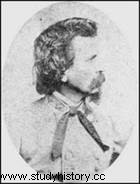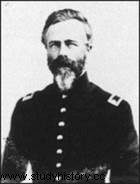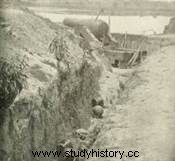 By the end of July 1862, the withdrawal of the Union fleets from Vicksburg and the evacuation of Natchez had left the Confederacy controls a significant portion of the course of the Mississippi , when the river was about to be entirely in the hands of the Northerners just a month earlier. Moreover, the epicenter of operations in the West had shifted to President Lincoln's usual politico-military fad, East Tennessee.
By the end of July 1862, the withdrawal of the Union fleets from Vicksburg and the evacuation of Natchez had left the Confederacy controls a significant portion of the course of the Mississippi , when the river was about to be entirely in the hands of the Northerners just a month earlier. Moreover, the epicenter of operations in the West had shifted to President Lincoln's usual politico-military fad, East Tennessee.
The bulk of the Union troops had been regrouped under Buell at Corinth, from where they were advancing – with maddening slowness – toward Chattanooga. Grant was left with forces unable to do more than occupy the conquered areas of western Tennessee and northern Mississippi. This situation, further accentuated by Butler's low numbers in Louisiana, meant that the North would not be able to take the initiative against Vicksburg for the rest of the summer.
The Battle of Baton Rouge
The Northerners' inaction and withdrawal of their ships was the perfect opportunity for the Southerners to regain the initiative along the Mississippi. Their situation was hardly favorable in terms of manpower, but they had the advantage of seeing the Federals struggling with the guerrillas which had been organized in response to the northern occupation. Southern partisans forced the blue soldiers to concentrate on defending their camps, depots and supply lines, all of which required large manpower and from which the regular Confederate troops suffered little or nothing - even if there were also Union supporters operating in territories still in Confederate hands.
Incidentally, the bulk of Southern forces in the West would also be used for other purposes, with President Davis aiming for an invasion of Kentucky. The task would be made easier for him by Buell's inaction, but at the same time he would leave few troops to operate along the Mississippi. Since being ordered out of Arkansas after its defeat at Pea Ridge in March, Earl Van Dorn's small army had arrived too late to participate in the Battle of Shiloh or the Siege of Corinth, but in time to reinforce the defenses of Vicksburg when necessary. Van Dorn did not have large numbers at his disposal:his own troops, Sterling Price's Missourians, and various scattered units including a brigade from Kentucky commanded by John Breckinridge.
 Although he was sometimes short of means, Van Dorn never lacked audacity or imagination – nor had he been chilled by the disastrous consequences of his boldness at Pea Ridge. Eager to extend his control of the Mississippi downstream, he mounted a combined operation to retake Baton Rouge . CSS River Battleship Arkansas would have to descend the river to rub shoulders with the Federal gunboats there, while a small division, entrusted to Breckinridge, would attack the town by land. On July 27, 1862, 5,000 men left Vicksburg for Camp Moore, a Confederate military installation in Tangipahoa Parish, East Louisiana (the parish is the Louisiana equivalent of the county in other states, only the name changes). /P>
Although he was sometimes short of means, Van Dorn never lacked audacity or imagination – nor had he been chilled by the disastrous consequences of his boldness at Pea Ridge. Eager to extend his control of the Mississippi downstream, he mounted a combined operation to retake Baton Rouge . CSS River Battleship Arkansas would have to descend the river to rub shoulders with the Federal gunboats there, while a small division, entrusted to Breckinridge, would attack the town by land. On July 27, 1862, 5,000 men left Vicksburg for Camp Moore, a Confederate military installation in Tangipahoa Parish, East Louisiana (the parish is the Louisiana equivalent of the county in other states, only the name changes). /P>
On the northern side, the city was defended by only a modest combined force of 2,500 men, comprising seven infantry regiments and four field artillery batteries. Everything was under the command of Brigadier-General Thomas Williams. The federal position was not very conducive to defense . The city, on the east bank of the Mississippi, was virtually unfortified. It extended over a slightly uneven terrain, in a region where the woods alternated with wide clearings. The only intrenchments had been dug in the northwest corner of the capital of Louisiana, around the main northern camp. Other camps were scattered around the city. On the river, two gunboats were likely to provide support:the USS Essex , battleship, and the USS Cayuga , in wood.
Map of Louisiana with the main localities concerned (annotations by the author on a background from the Perry-Castaneda map library).
Williams was very quickly informed of Breckinridge's advance by escaped slaves and then by his own patrols, which confirmed the presence of Southerners nearby on August 4. The long and exhausting march from Camp Moore had considerably stretched the small Southern army, and its leader estimated that at dawn on August 5 , he had barely half his men on hand for an attack – roughly the same strength as his opponent. Despite everything, Breckinridge attacked at four o'clock in the morning. The northern troops were not surprised, but unlike their adversaries, many of whom had fought at Shiloh, they had never seen fire.
 The soldiers in blue quickly lost ground, abandoning their camps on the edge of town and retreating in good order through the streets of the city . We fought fiercely in the middle of the municipal cemetery. General Williams was killed gathering forces for a counterattack, leaving command to Colonel Cahill, who managed to hold his small army together. Cruel combats were fought for six hours, in the streets swept by the contents of canisters fired relentlessly by the cannons, between the houses which offered so many shelters for snipers. Although cornered by the river, the Federals continued to resist. Paradoxically, their retreat ended up giving them a tactical advantage:it put the southern troops within firing range of the gunboats anchored on the Mississippi.
The soldiers in blue quickly lost ground, abandoning their camps on the edge of town and retreating in good order through the streets of the city . We fought fiercely in the middle of the municipal cemetery. General Williams was killed gathering forces for a counterattack, leaving command to Colonel Cahill, who managed to hold his small army together. Cruel combats were fought for six hours, in the streets swept by the contents of canisters fired relentlessly by the cannons, between the houses which offered so many shelters for snipers. Although cornered by the river, the Federals continued to resist. Paradoxically, their retreat ended up giving them a tactical advantage:it put the southern troops within firing range of the gunboats anchored on the Mississippi.
High-caliber projectiles from the Union ships soon slammed into the Confederate lines, causing heavy casualties to the Gray soldiers. Around ten o'clock, noticing that Arkansas had not arrived, contrary to what he expected, to attack the enemy gunboats, Breckinridge did not insist and sounded the retreat. The Battle of Baton Rouge ended in a northern victory . It had proven to be particularly deadly for the two belligerents. In all, 168 men had been killed. The North lost 383 soldiers, the South 456, or 839 killed, wounded and missing to report to some 5,000 combatants on both sides. Although small in scale compared to others, this engagement was not without consequences at the strategic level, as the sequence of events would demonstrate.
War on the Mississippi
 The Confederates might have won if Arkansas had been there, as Van Dorn's plan had called for. However, the river battleship was in poor condition after his various fights in July. Completed in a hurry, it lacked spare parts to ensure its maintenance, especially with regard to its machinery. The crew had also been seriously diminished by the casualties, including Captain Brown, still not recovered from the wound he had received on July 15. So much so that the officer had to request a few days leave, leaving command of the ship to his second in command, Henry Stevens. Brown ordered the 22-year-old lieutenant not to sail under any circumstances until he returned.
The Confederates might have won if Arkansas had been there, as Van Dorn's plan had called for. However, the river battleship was in poor condition after his various fights in July. Completed in a hurry, it lacked spare parts to ensure its maintenance, especially with regard to its machinery. The crew had also been seriously diminished by the casualties, including Captain Brown, still not recovered from the wound he had received on July 15. So much so that the officer had to request a few days leave, leaving command of the ship to his second in command, Henry Stevens. Brown ordered the 22-year-old lieutenant not to sail under any circumstances until he returned.
Van Dorn, however, expressly counted on the cooperation of Arkansas for the operation against Baton Rouge. He firmly ordered Stevens to head downriver, and eventually prevailed. The journey, however, proved calamitous and marked by recurring propulsion failures. So much so that on August 5, Arkansas was still too far from Baton Rouge to hope to support Breckinridge's men. The battleship did not arrive until the next day at the end of its journey, spotting its old enemy the Essex – which he had already faced twice – and preparing to engage the fight. This is the moment that his machines chose to give up the ghost for good. Stevens managed to beach it just long enough to set it on fire and evacuate it. Drifting downstream, Arkansas in flames ends up exploding around noon. Her brief three-week career thus completed, the Southern vessel ceased to be a threat to Union river forces.
 The Destruction of Arkansas would allow Union ships to navigate the Mississippi with more confidence. At Helena, Commodore Davis was thus able to mount a small expedition against the approaches to Vicksburg. On August 16, the two battleship gunboats USS Mound City and USS Benton , accompanied by five spur ships, surprised a Southern transport transhipping a load of arms from Vicksburg to Milliken's Bend, Arkansas. After seizing it, the small fleet continued on its way to the Yazoo River, which the Southerners had negligently omitted to put in a state of defence. This time, the Confederate installations on the Yazoo were devastated , depriving Vicksburg of significant amounts of supplies and equipment.
The Destruction of Arkansas would allow Union ships to navigate the Mississippi with more confidence. At Helena, Commodore Davis was thus able to mount a small expedition against the approaches to Vicksburg. On August 16, the two battleship gunboats USS Mound City and USS Benton , accompanied by five spur ships, surprised a Southern transport transhipping a load of arms from Vicksburg to Milliken's Bend, Arkansas. After seizing it, the small fleet continued on its way to the Yazoo River, which the Southerners had negligently omitted to put in a state of defence. This time, the Confederate installations on the Yazoo were devastated , depriving Vicksburg of significant amounts of supplies and equipment.
At the same time, Union ships patrolling the Mississippi began to be attacked with increasing frequency by snipers and partisan groups. As he had been in Baton Rouge in May, Farragut was ruthless. After a new attack, he had Donaldsonville, between Baton Rouge and New Orleans, burned and bombed on August 9 – not without giving the inhabitants time to evacuate the city. There were therefore no victims, but the harshness of the northern occupation was not made to reduce the activity of the southern guerrillas, quite the contrary. Meanwhile, the aggressiveness of the Confederates was beginning to worry General Butler, who was still short of soldiers. Deciding to concentrate around New Orleans, he evacuated Baton Rouge on August 21, after a large part of the city, already damaged by the fighting of the 5th, had been destroyed so as not to serve as a base for the southern army.
 Soon after, Essex began a solitary patrol up the Mississippi. The Union armored gunboat came under fire again at Bayou Sara, Louisiana, on August 24. In retaliation, Essex briefly bombarded the city. The same scenario repeated itself at Natchez on September 3, before the ship resumed its journey to New Orleans. It was on September 7, while passing the small hamlet of Port Hudson, that the Federal gunboat became acquainted with a major strategic consequence of the Battle of Baton Rouge and the evacuation of the city. The Confederates had installed batteries there, which opened fire. Although Essex was not seriously affected, it was clear that the Southerners were in Port Hudson to stay.
Soon after, Essex began a solitary patrol up the Mississippi. The Union armored gunboat came under fire again at Bayou Sara, Louisiana, on August 24. In retaliation, Essex briefly bombarded the city. The same scenario repeated itself at Natchez on September 3, before the ship resumed its journey to New Orleans. It was on September 7, while passing the small hamlet of Port Hudson, that the Federal gunboat became acquainted with a major strategic consequence of the Battle of Baton Rouge and the evacuation of the city. The Confederates had installed batteries there, which opened fire. Although Essex was not seriously affected, it was clear that the Southerners were in Port Hudson to stay.
After his retreat to Baton Rouge, Breckinridge had sent 1,500 men, commanded by Daniel Ruggles, to occupy Port Hudson . The site had a configuration similar to that of Vicksburg, although less imposing. Port Hudson was surrounded by steep hills, the sheer drops of which towered about 25 meters above the river. The Mississippi formed a tight meander there, making Northern ships all the easier targets. The location was therefore easy to fortify and defend. It also had a certain strategic interest. Located just downstream from the confluence of the Mississippi and the Red River, Port Hudson made it possible to protect the latter from northern incursions. However, in the absence of a major railway line, the Red River was the main communication route between overseas Mississippi (Texas, Louisiana, Arkansas) and the rest of the Confederacy. It could therefore continue to benefit from the resources of these regions as long as it controlled the portion of the Mississippi between Vicksburg and Port Hudson. These last two cities would at the same time become, for the North, priority objectives for the coming year.
Sources
- Article on the Battle of Baton Rouge and related operations.
- Factual summary of the Battle of Baton Rouge.
- General article about the battle.
- Digital version of the northern magazine Harper’s Weekly of September 6, 1862, reporting the Battle of Baton Rouge.
- Detailed account of naval operations on the Mississippi, both from downriver and upriver.